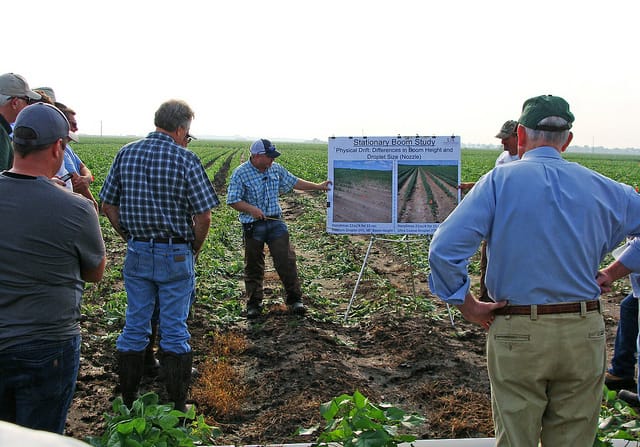Cornucopia’s Take: Despite the agency’s own findings of likely harm to endangered species, Trump’s Environmental Protection Agency approved Monsanto’s XtendiMax pesticide. Further, the EPA refused to seek guidance from other federal agencies and denied any risks at all from the dicamba-based product. Six public interest and environmentalist groups have stepped forward to challenge the EPA in court, describing the EPA’s behavior as “reckless” and “shocking.” Dicamba is not allowed in organic production.
FARMERS, CONSERVATIONISTS CHALLENGE TRUMP’S EPA, MONSANTO OVER CROP-DAMAGING PESTICIDE
Center for Food Safety
EPA Unlawfully Approved Monsanto’s XtendiMax Weed-Killer, Ignoring Warnings of Rampant Drift, Destroying Crops on Millions of Acres in Devastating 2017 Farm Season With More to Come
Evidence Shows Hundreds of Endangered Species at Risk and Unprotected
 |
Source: U of A, System Div. of Ag., |
On [February 9], public interest organizations representing farmers and conservationists made their legal case in a federal lawsuit against the Environmental Protection Agency (EPA) and the Monsanto Company, challenging EPA’s approval of Monsanto’s new “XtendiMax” pesticide. XtendiMax is Monsanto’s version of dicamba, an old and highly drift-prone weed-killer. EPA’s approval permitted XtendiMax to be sprayed for the first time on growing soybeans and cotton that Monsanto has genetically engineered (GE) to be resistant to dicamba.
The 2017 crop season – the first year of XtendiMax use – was an unprecedented disaster. Just as critics warned would happen, dicamba sprayed on Monsanto’s GE soybeans and cotton formed vapor clouds that drifted to damage a host of crops and wild plants. Over three million acres of soybeans as well as scores of vegetable and fruit crops, trees and shrubs throughout the country were damaged by dicamba drift. Flowering plants near cropland also suffered, with potential harms to pollinators, as well as hundreds of endangered animal and plant species. Agronomists reported they had never seen herbicide-related drift damage on anything approaching this scale before. As the 2018 season approaches, experts predict similar widespread devastation.
“The evidence shows that, rather than protecting farmers and the public interest, government officials rushed this pesticide to market without the rigorous analysis and data the law requires,” said George Kimbrell, of the Center for Food Safety and counsel in the case. “There was good reason that decision had such devastating consequences last year: it was illegal.”
The papers filed in Court tell the story of how EPA should have known this would occur, yet instead was pressured by Monsanto into approving the pesticide without any measures to prevent vapor drift. The evidence in the case also shows that in late 2017, under pressure to take some action, EPA adopted revised instructions for use Monsanto proposed and approved – measures that agronomists believe will again be ineffective.
Denise O’Brien, Iowa farmer and Board president of Pesticide Action Network, said, “Last year, EPA ignored concerns of farmers, caving to Monsanto’s pressure and rushing dicamba-resistant seeds to market. EPA has failed utterly to protect farmers from this exploding crisis.”
Ben Burkett, National Family Farm Coalition board president raising soy, old growth pine trees and roughly 20 different vegetables in Mississippi commented: “I’m firmly against using dicamba. Mother Nature will win this fight anyway, but dicamba is very detrimental to the environment and will cause more harm than good to farms and farmers.”
Not only did EPA fail to protect farmers, it put at risk literally hundreds of endangered species. Despite its own conclusion that the approval might harm an extraordinary number of the protected birds, mammals and insects in dozens of states, EPA refused to seek the guidance of the federal expert wildlife agencies, as the Endangered Species Act requires, and instead approved Monsanto’s pesticide without any measures to protect them, and denied there would be any risk.
Earthjustice attorney Paul Achitoff said, “EPA’s disregard of both the law and the welfare of endangered whooping cranes, grey wolves, Indiana bats, and hundreds of other species at risk of extinction is unconscionable. That the EPA would indulge in this kind of recklessness and junk science to appease Monsanto is shocking.”
“The EPA’s foolish approval of dicamba left a deep scar across millions of acres of farms and forests,” said Nathan Donley, a senior scientist at the Center for Biological Diversity. “The ill-advised rush to approve this dangerous drift-prone pesticide reflects just how far the EPA has strayed from its duty to protect Americans and wildlife from harmful toxins.”
The plaintiff organizations bringing the lawsuit are National Family Farm Coalition, Pesticide Action Network, Center for Food Safety, and Center for Biological Diversity, represented jointly by legal counsel from Earthjustice and Center for Food Safety.
For more information, please see Frequently Asked Questions about Monsanto’s Dicamba-Resistant Crops and XtendiMax.

